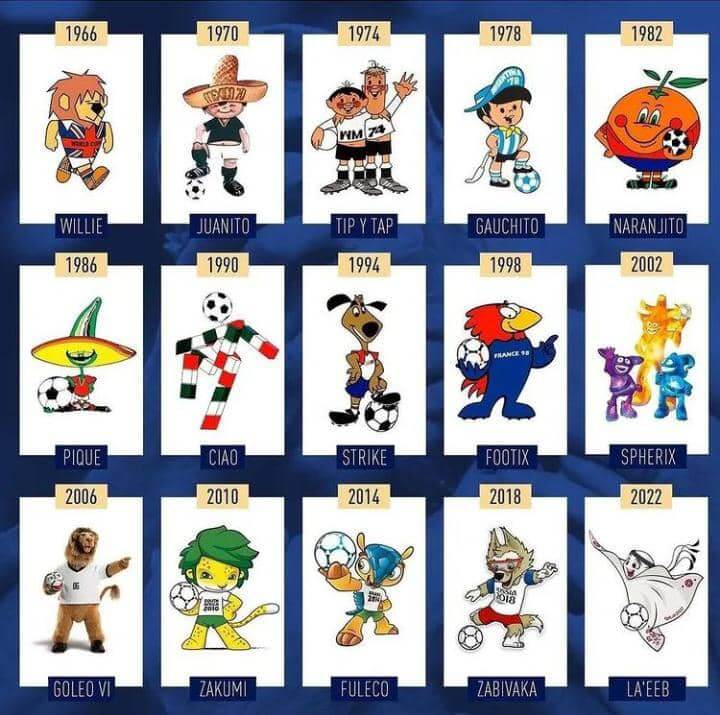The World Cup is the most important sporting event and the one that generates the greatest expectations among soccer fans around the world. One of the most striking things about this sporting event is the mascot: What character will it be? How will it be dressed? Who is the illustrator or designer? These are some of the questions we fans ask ourselves. That is why we invite you to get to know all the mascots of the World Cups that have existed.
These Are the 15 World Cup Mascots
1. La’Eeb Arrives at Qatar 2022 From the Mascot-Verse With Airs of Liberation
The 2022 World Cup is approaching and with it many interesting and fun things. One of the most popular themes among young and old alike is the World Cup mascot. In 2022, we will enjoy La’eeb, a kind of animated character that represents a turban, a characteristic symbol of Qatari culture.
The name of the Qatar 2022 mascot La`ebb means to liberate or liberation in Arabic. La’eebb comes from the mascot-verse, the place where the magic happens, with the responsibility of being the mascot of the first World Cup to be held in the Middle East.
The table is set and La’eeb will be the center of attention. We know he will do a great job, so we can only wait for the Qatar 2022 World Cup to start and enjoy his witticisms.
2. Zabivaka, the Russia 2018 World Cup Mascot That Was Full of Charisma and Sympathy
Zabivaka is a wolf that won the sympathy of the whole world at the Russia 2018 World Cup. Dressed in red shorts, a white and blue T-shirt and ski goggles, Zabivaka stood out for being charming, dreamy and outgoing, something that fans always appreciated with applause and smiles all his charm.
The Russia 2018 mascot was created by a young design student from Siberia named Ekaterina Bocharova, while her name means little striker.
3. Fuleco, One of the Mascots of the World Cup That Scored an Environmental Goal
In Brazil 2014 the official mascot was called Fuleco, a name born from combining the words “soccer” and “ecology”.
Fuleco is a three-striped armadillo wearing green shorts, a white T-shirt that says Brazil 2014, and yellow t-shirts on his arms and legs.
4. Meet Zakumi the Mascot That Together With Shakira Made the Party in South Africa 2010
Zakumi is a funny yellow leopard with green pants, eyes and hair, holding a ball and wearing a white T-shirt with the legend South Africa 2010.
One of the mascots of the World Cups with the most rhythm, don’t you think?
The name Zakumi comes from the combination of ZA which is a shortened form of South Africa, and kumi which is a translation of the important number ten in several African languages.
5. Goleo VI and Pille Made a Great Duo as Mascots of the 2006 World Cup in Germany
Goleo VI, a big lion that could roar, and Pille, a talking ball, were the mascots of the 2006 World Cup in Germany. A curious fact is that Goleo VI is the brother of Willie, the first official mascot in the history of the World Cup, who made his debut in England 1966.
Goleo, wearing a white T-shirt with the number 6 on his chest, and Pille, a talking ball, caused a furor among fans, who enjoyed the 2006 World Cup in the company of these two magnificent mascots.
6. From Imagination and Fantasy Came the Spheriks (Ato, Kaz and Nik) The Mascots of the 2002 Korea-Japan World Cup
The 2002 World Cup had a duo in the organization (Korea and Japan) and a trio in the mascots (Ato, Kaz and Nik). Inspired by Japanese cartoons, these mascots live high in the sky in a place called Atmozone, where they play a unique version of soccer called Atmoball, where they take care to create a great sporting atmosphere.
Within this fantasy world, Ato (Yellow) is the DT, Kaz (Violet) and Nik (Blue) are the players. This fantastic story had its own television series, produced by FIFA to market the World Cup.
These are the most modern mascots of the World Cup… so far!
7. Footix, the Rooster That Animated the 1998 World Cup in France
France 1998 enjoyed Footix, a rooster that reminded us of Willie, the first official mascot of the World Cup in England 1966.
It’s one of the World Cup mascots that best represents its country, isn’t it?
Footix in the colors of the French flag, representing Gaul or Gaul (France), always proved to be cheerful, radiant and great with the ball.
8. Meet Striker, the USA 94 Mascot
Striker is a funny little soccer dog that represented the mascot of the World Cup held in the United States in 1994. This friendly canine was designed by Warner Bros and wore a soccer uniform with the colors of the United States flag (white, red and blue).
Striker represented the typical dog that is part of many American households. A curious fact about this mascot is that it was the first to be chosen by public vote.
This is one of the most popular World Cup mascots in the homes of the host country, don’t you think?
9. Ciao, the Only World Cup Mascot That Did Not Have a Face
This is the mascot of the World Cup Italy 90, and has been one of the most controversial World Cup mascots in history, and this is because of its design.
Ciao, which means hello and goodbye in Italian, is a humanoid figure made of red, white and green cubes (the colors of the Italian flag), with a soccer ball for a head.
Many thought that this “futuristic” figure for its time did not represent at all the great Italian culture, rich in symbols and traditions. As a result, it was heavily criticized by the Italian press and the general public.
10. Pique, the Jalapeño Mascot of Mexico 1986
The name of this peculiar mascot comes from the “spicy” that characterizes Mexican food, which is intangible heritage of humanity for its ancient tradition and its delicious and varied dishes that we all love.
Pique was a chile wearing a big Mexican hat and a thick mustache, both very representative of Mexicanness. This is the second mascot in history represented by a vegetable.
A curiosity of this World Cup is that Cantinflas was going to be the mascot of the World Cup, it was even announced in 1985, but unfortunately, some groups of Mexican society did not think he would be a good representative.
Can you imagine Cantinflas as a mascot for Mexico 1986? That would have been awesome!
11. Naranjito, Mascot of the 1982 World Cup in Spain
This was the first of the World Cup mascots represented by a fruit or vegetable. You should already know from its name that the mascot of the 1982 World Cup in Spain was an orange, which was chosen in honor of the sweet Valencian oranges.
Naranjito was wearing the colors of Spain for that World Cup, and he had a wide and funny smile.
A curiosity about this mascot is that he had his own television show. It was a cartoon series called “Football in Action” and each episode lasted 20 minutes. The Naranjito series had a total of 20 chapters, see a little bit of what it was like here:
12. Gauchito, That Was the Name of the Mascot of Argentina 1978
This boy from the Argentinean Pampas wore the colors of his country’s national team, a beautiful typical hat that said “Argentina 78”, black and white boots, a small whip in his hand and a handkerchief tied around his neck.
Something that attracted a lot of attention was that Gauchito wore the “Puma” logo on both his jersey and boots, although FIFA in those years was related to the ADIDAS brand. How curious!
Many people criticized him for looking too much like Juanito, mascot of the 1970 World Cup held in Mexico, because both were mascots who were children and had a soccer ball on their foot, as well as a very similar pose.
13. Tip and Tap, the Mascots of Germany 1974
This pair of siblings made history by being the first time there were two official mascots in a World Cup. Tip was short and dark, while Tap was tall and blond. Incidentally, Tap has a sausage-shaped head, which is a food for which Germany is world-renowned.

Something very curious about these characters is that they represented the two Germanys, the Federal Republic of Germany (FRG) and the German Democratic Republic (GDR), which were separated by the Berlin Wall. Another curious fact is that the ball the brothers have was completely white.
The two children were wearing the German uniform by then. Tip had on his jersey the letters “WM” for the German word Weltmeisterschaft, meaning World Cup, while Tap’s jersey showed the number 74, which was the year of that World Cup.
14. Juanito, This Is the Name of the Mascot of Mexico 1970
Juanito was an eleven-year-old boy who represented fair play together with the innocence that characterizes young children. It was the first World Cup mascot to represent a human being.
He was wearing a Mexican sombrero, the green jersey of his national team, white shorts, and had a ball at his feet. In addition, his hat read “Mexico 70”.
As a curious fact, Juanito was the first mascot seen on television because Mexico 1970 was the first World Cup to be broadcast live.
15. What Was the First World Cup Mascot? Willie!
This friendly lion is the one who started it all on the subject of World Cup mascots. Willie is the first mascot of a World Cup, that of England in 1966.
World Cup Willie, or simply “Willie”, had a national team jersey in the colors representing England, and he looked very funny playing with a soccer ball.
As a curious fact about Willie, we can tell you that the song of that World Cup had the same name as his mascot.
The official song of England 1966 was sung by Lonnie Donegan. Listen to it here:
Which of these World Cup mascots is your favorite?
If you want to know what are the 4 best soccer player tattoos in 2022 and their meaning you have to check out this article.







Comments